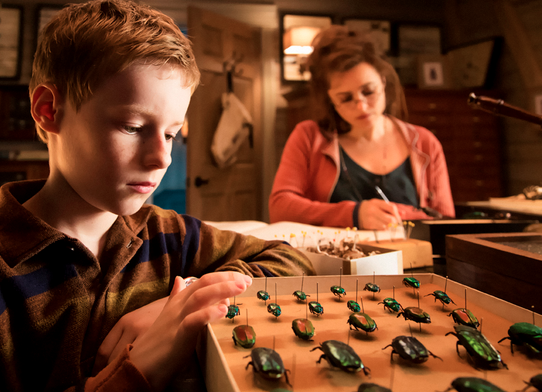
The fact that the book–deemed a member of ergodic literature for its requirement of the reader to engage more dynamically with the text–was adapted into a film almost immediately is telling of what a commodity the whimsy of the story holds. While released in France in 2013, The Young and Prodigious T.S. Spivet is only just now making its way stateside (the Weinsteins have a backlog of film canisters to be distributed, evidently). Its quiet and modest debut is in direct contrast to the sweeping and bombastic nature of the narrative.

Set on a Montana farm on which the Spivet family leads a fairly insular and contented life, their picturesque existence is turned on its ear when T.S.’s (Kyle Catlett) twin brother, Layton (Jakob Davies), dies as a result of an accidental self-inflicted gunshot wound in their barn. Thereafter, “no one ever talked about it,” leaving T.S. to believe it was his fault because he was the one running tests on the bullet frequencies and patterns (he’s a scientific-minded genius, after all, who just wanted to find a way for him and his brother to share common ground when it came to “playing.”).

Feeling like a pariah in his own family, T.S. seizes an opportunity to go to Washington D.C. after he is contacted by G.H. Jibsen (Judy Davis, who looks much more feminine now that she’s no longer starring in Woody Allen movies), one of the heads of the Smithsonian, and is informed that his invention of a perpetual motion machine has landed him the Baird award. Using his intelligence to get him across the country via train (the old nostalgia of Americana at play throughout the journey), we are given Jeunet’s best cinematographic visuals–indeed, the film won a César Award for it–the viewer is struck by how Wes Anderson-esque his style is. Or rather how Jeunet-esque Anderson’s aesthetic is. One could argue that Jeunet pioneered the now omnipresent whimsy trend in film–ranging from Spike Jonze to Michel Gondry. Interestingly, Gondry’s last film, Mood Indigo, also came out in 2013, was also based on a book and was also received in American theaters with a lukewarm response.

And yet, for as impressive The Young and Prodigious T.S. Spivet is from an ocular standpoint, it is most moving for the emotional response it evokes–which could very well have to do with the uncontrived acting of first-timer Kyle Catlett. For example, when T.S. finally rehashes the story of how Layton died, one immediately gets into his guilt-racked mindset. It is one of many moments in the movie during which the heartstrings are pulled. His innocence and nobility come across in every line of dialogue, such as, “The interesting thing about raindrops is that they always take the path of least resistance. It’s the opposite with humans.” But for all its profoundness and endearment, it would appear that this piece of majesty might remain under the radar among U.S. audiences.






















